#devops fundamentals
Explore tagged Tumblr posts
Text
Accelerate Your DevOps Career with AWS Bootcamp Training
In today's fast-paced digital landscape, the demand for efficient and agile IT practices has never been higher. As organizations continue to adopt cloud-native applications and microservices architectures, DevOps fundamentals have become a cornerstone of successful IT operations. Among the myriad of cloud platforms, AWS (Amazon Web Services) stands out as a leader in providing robust cloud infrastructure that fuels innovation and scalability.
This comprehensive guide explores how AWS Bootcamp Training can accelerate your DevOps career. We delve into key concepts like Continuous Integration (CI), Continuous Deployment (CD) with AWS, Infrastructure as Code (IaC), and many other essential components. Whether you’re an aspiring DevOps professional or a seasoned engineer looking to upgrade your skills, this bootcamp offers the practical experience and cutting-edge knowledge needed to thrive in a cloud-centric world.

Why DevOps is Critical for Modern IT
Transforming IT Operations
DevOps is more than just a set of practices—it’s a cultural transformation that bridges the gap between development and operations teams. By adopting DevOps best practices, companies can streamline software development, reduce deployment times, and respond to market demands swiftly. DevOps empowers teams to:
Automate repetitive tasks to minimize human error.
Enhance collaboration across different departments.
Implement robust version control with Git to manage code efficiently.
Increase scalability with AWS by leveraging cloud-native solutions.
The ability to seamlessly integrate development, testing, and deployment processes is what gives businesses a competitive edge in today’s fast-paced environment.
The Power of AWS in DevOps
Leading Cloud Infrastructure
AWS offers an extensive range of cloud services that have revolutionized the way applications are built, deployed, and managed. Its comprehensive suite of tools includes computing power, storage, databases, analytics, and machine learning services—all of which are crucial for modern DevOps practices.
Key AWS DevOps Tools
Understanding the AWS ecosystem is essential for any DevOps professional. Here are some of the critical AWS tools that are often covered in a bootcamp setting:
AWS CloudFormation: Allows you to model and set up your AWS resources using templates, automating the provisioning of infrastructure as code.
AWS CodePipeline: Facilitates continuous integration and continuous deployment (CI/CD) by automating the build, test, and deploy phases.
AWS CodeDeploy: Automates code deployments to any instance, including AWS EC2 and on-premises servers.
AWS Lambda for DevOps: Enables you to run code in response to triggers without provisioning or managing servers.
AWS Elastic Beanstalk: Simplifies the deployment and management of applications by handling the underlying infrastructure.
AWS EC2 for DevOps: Offers scalable computing capacity, which is critical for running applications, containers, and microservices.
Each of these tools plays a vital role in automating processes and ensuring that the DevOps lifecycle is efficient and error-free.
Key Components of AWS Bootcamp Training
A well-structured AWS Bootcamp is designed to cover the entire DevOps lifecycle—from planning and development to deployment and monitoring. Below are some of the core areas of focus:
1. DevOps Fundamentals
Before diving into the specifics of AWS, bootcamps lay the groundwork with essential DevOps fundamentals. This includes:
An introduction to agile methodologies.
The significance of continuous integration (CI) and continuous deployment (CD).
Best practices in collaboration, version control with Git, and security in DevOps.
Understanding these core principles is critical, as they form the backbone of effective DevOps practices and set the stage for more advanced topics.
2. AWS Cloud Infrastructure
Participants gain hands-on experience with AWS cloud infrastructure. Training modules typically cover:
Setting up and managing virtual servers using AWS EC2 for DevOps.
Configuring secure, scalable storage solutions.
Networking and security configurations to protect sensitive data and applications.
This foundational knowledge ensures that you can deploy and manage applications confidently in a cloud environment.
3. Continuous Integration and Continuous Deployment (CI/CD)
Automation is a key theme in DevOps, and bootcamps place significant emphasis on CI/CD pipelines. Trainees learn how to:
Set up automated pipelines using AWS CodePipeline.
Integrate testing frameworks to ensure code quality.
Deploy applications seamlessly using AWS CodeDeploy.
By mastering CI/CD with AWS, you can dramatically reduce release cycles and improve overall software quality.
4. Infrastructure as Code (IaC)
Infrastructure as Code is revolutionizing how IT infrastructure is provisioned and managed. Bootcamp sessions on Infrastructure as Code (IaC) typically include:
Hands-on training with AWS CloudFormation to automate resource provisioning.
Best practices for versioning infrastructure configurations.
Strategies for scaling applications reliably using code-based infrastructure management.
IaC not only improves consistency and reliability but also enhances the overall security and manageability of cloud deployments.
5. Monitoring and Logging in AWS
After deployment, monitoring and logging become critical to maintain performance and identify issues quickly. Training covers:
Implementing monitoring solutions to track application performance.
Using AWS logging tools to troubleshoot and resolve issues.
Integrating monitoring solutions with automated alerts to ensure proactive maintenance.
These practices help ensure that your deployed applications remain robust and perform optimally, even under variable load conditions.
6. Containerization with Docker on AWS
Modern DevOps practices often involve containerization to ensure portability and scalability. Bootcamp training on Containerization with Docker on AWS typically covers:
Building and managing Docker containers.
Deploying containerized applications on AWS.
Leveraging AWS services like AWS Elastic Beanstalk and Amazon ECS (Elastic Container Service) for container orchestration.
Containerization simplifies application deployment and scaling, making it an invaluable skill for modern DevOps professionals.
7. Advanced AWS DevOps Tools and Best Practices
The AWS Bootcamp Training also introduces advanced topics such as:
AWS Lambda for DevOps: Using serverless computing to enhance agility.
Security in DevOps: Integrating security best practices into every stage of the DevOps lifecycle.
Scalability with AWS: Leveraging AWS to build systems that scale effortlessly in response to demand.
These advanced modules ensure that participants are not just familiar with AWS tools, but can also apply DevOps best practices to create robust, scalable, and secure systems.
Benefits of AWS Bootcamp Training
Accelerated Learning Curve
One of the primary advantages of an AWS Bootcamp is its intensive curriculum that compresses months or even years of learning into a short, focused period. This accelerated learning curve means that you can rapidly acquire the skills necessary to:
Implement Continuous Integration (CI)
Master Continuous Deployment (CD) with AWS
Apply Infrastructure as Code (IaC) principles
Hands-On Practical Experience
Bootcamp training emphasizes practical, real-world applications. You’ll work on projects that mimic industry scenarios, ensuring that you gain:
Practical experience with AWS DevOps tools.
A solid understanding of Automation in DevOps.
The ability to design, deploy, and manage cloud infrastructure effectively.
This hands-on approach ensures that you are job-ready as soon as you complete your training.
Enhanced Career Opportunities
With the rapid growth of cloud computing and the rising importance of DevOps, professionals with AWS skills are in high demand. Graduates of AWS Bootcamp Training are well-positioned to:
Drive innovation in their organizations.
Implement scalable, secure, and efficient cloud solutions.
Lead initiatives that leverage AWS cloud infrastructure for business transformation.
Whether you’re looking to advance within your current role or transition into a new career, the skills acquired through bootcamp training are highly marketable.
Networking and Mentorship
AWS Bootcamp Training also provides valuable networking opportunities. You’ll connect with like-minded professionals, experienced mentors, and industry experts who can guide your career growth. The community aspect of a bootcamp is invaluable for:
Exchanging ideas and best practices.
Staying updated with the latest trends in DevOps and cloud computing.
Receiving career support and advice from seasoned professionals.
Implementing DevOps Best Practices with AWS
To truly reap the benefits of your AWS Bootcamp training, it’s important to integrate the knowledge and skills you’ve acquired into your daily work. Here are some strategies to implement DevOps best practices:
1. Automate Everything
Automation lies at the heart of DevOps. Whether it’s code deployment or infrastructure provisioning, automate repetitive tasks using tools like AWS CodePipeline, AWS CodeDeploy, and AWS CloudFormation. Automation not only reduces human error but also accelerates your development lifecycle.
2. Embrace Continuous Integration and Deployment
By setting up robust CI/CD pipelines, you ensure that your code is constantly tested and deployed. This approach minimizes the risks associated with manual deployments and allows you to quickly roll back changes if necessary.
3. Leverage Version Control with Git
Effective version control is essential for tracking changes and collaborating with your team. Use Git to manage code repositories, merge changes, and maintain a detailed history of your projects. This practice is fundamental to successful DevOps operations.
4. Focus on Security and Compliance
Security in DevOps is critical, especially when dealing with sensitive data and complex cloud infrastructures. Implement security best practices at every stage of the development lifecycle. Utilize AWS security tools and protocols to protect your applications and data from threats.
5. Monitor, Log, and Optimize
After deployment, continuous monitoring and logging are crucial for maintaining the health and performance of your applications. Use AWS monitoring tools to gain insights into system performance, identify bottlenecks, and optimize resource utilization. Regularly review logs to troubleshoot issues and refine your processes.
6. Stay Agile and Adaptive
The world of DevOps is ever-changing. Stay agile by continuously learning, experimenting with new tools, and adapting to emerging trends. Embrace a culture of continuous improvement that allows you to refine your processes and drive innovation.
Real-World Use Cases and Success Stories
Case Study: Automating Deployment with AWS CodePipeline
Consider an organization that faced challenges with slow, error-prone manual deployments. By implementing an automated pipeline with AWS CodePipeline and AWS CodeDeploy, the company was able to reduce deployment times from hours to minutes. This transformation not only increased operational efficiency but also enhanced product quality and customer satisfaction.
Case Study: Infrastructure as Code Transformation
Another success story comes from a team that transitioned from manual server provisioning to using AWS CloudFormation for IaC. This change enabled them to manage their cloud infrastructure with greater consistency, reduce downtime during deployments, and achieve a scalable architecture that could quickly adapt to increased demand.
The Impact on Career Growth
Many professionals who have completed AWS Bootcamp Training report significant career advancements. Whether it’s stepping into a DevOps leadership role or transitioning into a specialized cloud engineering position, the skills acquired from bootcamp training open doors to new opportunities. These professionals not only implement AWS cloud infrastructure efficiently but also become ambassadors of DevOps best practices within their organizations.
The Future of DevOps and AWS
As technology continues to evolve, the synergy between DevOps and AWS will become even more pronounced. Here’s what to expect in the coming years:
Increased Automation and AI Integration
The integration of artificial intelligence and machine learning into DevOps tools is on the rise. Future AWS DevOps tools are expected to incorporate predictive analytics and intelligent automation, further streamlining the development and deployment processes.
Greater Emphasis on Containerization and Serverless Architectures
With the growing adoption of containerization with Docker and serverless computing via AWS Lambda for DevOps, the future landscape will emphasize lightweight, agile, and highly scalable application architectures.
Enhanced Security and Compliance Frameworks
As cyber threats become more sophisticated, integrating robust security measures into DevOps workflows will remain a priority. Continuous monitoring, automated compliance checks, and real-time threat detection will be essential components of future AWS solutions.
Continuous Learning and Upskilling
The rapid pace of technological change means that continuous learning is more important than ever. Participating in advanced bootcamps, workshops, and training sessions will be critical for professionals who want to stay ahead of the curve in the competitive field of DevOps.
Conclusion
AWS Bootcamp Training is an excellent investment for anyone looking to accelerate their DevOps career. By covering essential topics—from DevOps fundamentals and AWS cloud infrastructure to Continuous Integration (CI), Continuous Deployment (CD) with AWS, and Infrastructure as Code (IaC)—this training equips you with the practical skills and hands-on experience required to thrive in a competitive market.
You’ll learn how to effectively use a suite of powerful AWS DevOps tools such as AWS CloudFormation, AWS CodePipeline, AWS CodeDeploy, and more. In addition, you’ll master key practices in automation, containerization with Docker, and monitoring and logging in AWS, all while staying true to DevOps best practices.
As cloud computing continues to evolve, the integration of advanced technologies like serverless computing and container orchestration will further enhance the potential of AWS. By staying agile, embracing continuous improvement, and leveraging the latest AWS technologies, you can build scalable, secure, and resilient systems that drive business success.
Take the Next Step in Your DevOps Journey with Kodestree
If you’re ready to transform your career and gain hands-on expertise in AWS and DevOps, consider enrolling in an AWS Bootcamp Training program. At Kodestree, we offer comprehensive, industry-focused courses that empower you to master essential AWS tools and DevOps practices. Whether you’re new to the field or looking to upskill, our training programs provide the practical knowledge and real-world experience needed to accelerate your career.
Enroll today at Kodestree and take the first step towards becoming a leader in DevOps. Embrace the future of cloud computing and automation—your journey to success starts now!
0 notes
Text
Ace Your DevOps Interview with Our DevOps Interview Questions and Answers
Prepare for success with our comprehensive DevOps Interview Questions and Answers. This collection of important questions and answers will help you gain the confidence you need to succeed in interviews for DevOps roles. Whether you're in the middle of online DevOps training or just starting, our DevOps interview preparation materials will guide you through key topics and common questions. As a leading DevOps training provider, we ensure you’re interview-ready and can easily tackle any DevOps-related questions.
#DevOps Interview Questions and Answers#learn devops basics online#devops fundamentals#affordable devops training programs
1 note
·
View note
Text
#azure data engineer#azure course#azure training#azure online training#azure certification#microsoft azure certification#azure certification path#azure fundamentals#azure devops certification#azure cloud certification#microsoft azure fundamentals
1 note
·
View note
Text
Maven Essential Tutorial for Beginners with Demo 2021 | Part -1
AiOps & MLOps School empowers IT professionals through hands-on training, certifications, and expert mentorship, combining practical skills with industry insights. We offer training, certification, guidance, and consulting for DevOps, Big Data, Cloud, dataops, AiOps, MLOps, DevSecOps, GitOps, DataOps, ITOps, SysOps, SecOps, ModelOps, NoOps, FinOps, XOps, BizDevOps, CloudOps, SRE and PlatformOps. 🔔 Don't Miss Out! Hit Subscribe and Ring the Bell! 🔔 👉 Subscribe Now
0 notes
Text
Azure Fundamentals (AZ-900) Online Training - NareshIT
Azure Fundamentals (AZ-900) Online Training - NareshIT
Description:
The Azure Fundamentals course covers a wide range of topics essential for understanding cloud computing and Azure services. These topics include cloud concepts, core Azure services, security, privacy, compliance, and Azure pricing and support. The course provides a comprehensive overview of Azure's capabilities, enabling learners to understand how Azure can benefit businesses and organizations of various sizes and industries.
Course Objectives:
Understanding cloud concepts, such as the benefits of cloud computing, different cloud models (public, private, hybrid), and cloud deployment models.
Exploring core Azure services, including compute, storage, networking, and databases.
Learning about Azure solutions for various scenarios, such as Internet of Things (IoT), artificial intelligence (AI), and machine learning (ML).
Understanding security, privacy, compliance, and trust in Azure.
Familiarizing with Azure pricing, service level agreements (SLAs), and support options.
Prerequisites:
The Azure Fundamentals course (AZ-900) does not have any specific prerequisites. It is designed for beginners and individuals who are new to cloud computing and Azure. However, having a basic understanding of IT concepts and familiarity with the internet and web services can be beneficial.
Who can learn this course:
IT professionals looking to expand their knowledge of cloud computing and Azure.
Students or recent graduates interested in pursuing a career in cloud computing or Azure.
Business decision-makers and stakeholders who want to understand the benefits and possibilities of adopting Azure for their organizations.
Anyone interested in gaining a foundational understanding of cloud computing concepts and Azure services.
Training Features:
Comprehensive Course Curriculum
Experienced Industry Professionals
24/7 Learning Access
Comprehensive Placement Programs
Hands-on Practice
Lab Facility with Expert Mentors
Conclusion:
Microsoft Azure online training provides a flexible and effective way to acquire valuable cloud computing skills and advance your career. By choosing the right course and committing to your learning journey, you can become proficient in Azure and take full advantage of its powerful capabilities.
0 notes
Text

O que você vai estudar </>
Conheça os conteúdos dos módulos da Formação DevOps Fundamentals.
Quem vai te guiar nesta jornada </>
Alexsandro Lechner
DEVOPS ENGINEER
"Aprenda os fundamentos para iniciar na carreira DevOps"
Saiba mais em DIO - Cursos
0 notes
Text
youtube
#az900#azure fundamentals#certification#technology#azure#youtube#microsoft#azure devops#microsoft azure#Youtube
0 notes
Text
Automated Testing vs. Manual Testing: Which One is Right for Your Project?

Achieving high-quality, reliable software stands as a fundamental requirement in software development. Successful testing functions as an essential tool to discover faults and build performance capabilities that create better user experience outcomes. Two main testing methods dominate the field: automated testing and manual testing. The process of quality software assurance uses different testing approaches that demonstrate their own advantages as well as weaknesses according to specific project requirements and scenarios. We will explore the specifics to determine which testing process works best for your system development efforts.
1. What Is Manual Testing?

Manual testing involves a human tester manually executing test cases without using automation tools. Key Characteristics:
The methodology focuses its efforts on user interface together with usability and experience testing.
Human-centered applications where selection requires discretion include ad hoc testing and enumerative testing as well as examinations that need human evaluation.
Human performers are required during this approach; thus, it demands substantial time.
2. What Is Automated Testing?
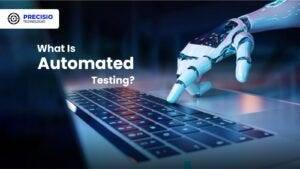
Software performing automated testing executes test cases through workflows and helpers. Key Characteristics:
Efficient for repetitive and regression testing.
Users must spend money on tools along with developing custom scripts for testing.
Reduces human error.
3. Advantages of Manual Testing

Human Intuition: Software testing professionals can detect kernels through their human cognitive ability that automated tools cannot match. The observation and evaluation of visual elements runs more efficiently through human operatives instead of advanced tools.
Flexibility: This method suits exploratory testing specifically because there are no pre-determined scripts available.
Low Initial Investment: Running this approach does not need tool purchases or applications to develop automation frameworks.
Adaptable for UI/UX Testing: Running this approach does not need tool purchases or applications to develop automation frameworks.
4. Advantages of Automated Testing
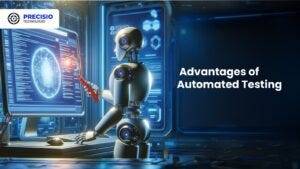
Speed: Executes repetitive tests much faster than humans.
Scalability: The system proves most effective for extensive projects that need constant system updates.
Accuracy: When performing recurring actions, automated systems minimize the chances of human mistakes.
Cost-Efficient in the Long Run: Once established and implemented, the system demands costly investments but ensures continuous development expenses decrease over time.
Better for CI/CD Pipelines: Such testing technology connects various development pipelines that support agile and DevOps methodologies.
5. Disadvantages of Manual Testing

Time-Consuming: The manual performance of repeated tests leads to delayed completion of projects.
Error-Prone: Large applications contain tiny bugs that human testers commonly fail to detect.
Not Ideal for Scalability: The process of increasing manual testing needs additional testers to avoid cost escalations.
6. Disadvantages of Automated Testing
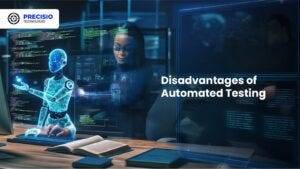
Initial Costs: Organizations must provide high financial resources to procure testing tools together with developing programming constructs.
Limited to Pre-Defined Scenarios: These testing approaches work poorly for handling exploratory or ad hoc testing.
Requires Maintenance: Test scripts need frequent updates when application changes occur.
Not Suitable for UI/UX Testing: Struggles with subjective user experience evaluations.
7. When to Use Manual Testing

Small Projects: The testing method proves beneficial at a low cost for small applications and provides quick assessments.
Exploratory Testing: Testing this approach benefits projects whose scripts have not been defined yet or need evaluation for newly added features.
Visual and Usability Testing: Performing assessments on interface components together with design features.
8. When to Use Automated Testing
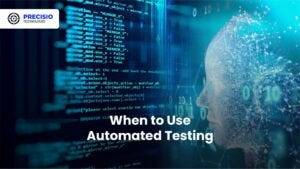
Large Projects: Handles scalability for projects with frequent updates.
Regression Testing: Program testing becomes more efficient through automation since automated assessments perform multiple tests following each update process.
Performance Testing: The system performs efficient capabilities to conduct load testing and stress testing.
Continuous Development Environments: Agile progression and DevOps implementations need automation as a core requirement.
READ MORE- https://www.precisio.tech/automated-testing-vs-manual-testing-which-one-is-right-for-your-project/
2 notes
·
View notes
Text
The Roadmap to Full Stack Developer Proficiency: A Comprehensive Guide
Embarking on the journey to becoming a full stack developer is an exhilarating endeavor filled with growth and challenges. Whether you're taking your first steps or seeking to elevate your skills, understanding the path ahead is crucial. In this detailed roadmap, we'll outline the stages of mastering full stack development, exploring essential milestones, competencies, and strategies to guide you through this enriching career journey.

Beginning the Journey: Novice Phase (0-6 Months)
As a novice, you're entering the realm of programming with a fresh perspective and eagerness to learn. This initial phase sets the groundwork for your progression as a full stack developer.
Grasping Programming Fundamentals:
Your journey commences with grasping the foundational elements of programming languages like HTML, CSS, and JavaScript. These are the cornerstone of web development and are essential for crafting dynamic and interactive web applications.
Familiarizing with Basic Data Structures and Algorithms:
To develop proficiency in programming, understanding fundamental data structures such as arrays, objects, and linked lists, along with algorithms like sorting and searching, is imperative. These concepts form the backbone of problem-solving in software development.
Exploring Essential Web Development Concepts:
During this phase, you'll delve into crucial web development concepts like client-server architecture, HTTP protocol, and the Document Object Model (DOM). Acquiring insights into the underlying mechanisms of web applications lays a strong foundation for tackling more intricate projects.
Advancing Forward: Intermediate Stage (6 Months - 2 Years)
As you progress beyond the basics, you'll transition into the intermediate stage, where you'll deepen your understanding and skills across various facets of full stack development.
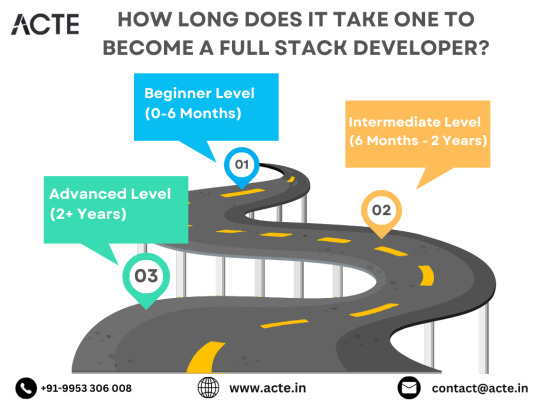
Venturing into Backend Development:
In the intermediate stage, you'll venture into backend development, honing your proficiency in server-side languages like Node.js, Python, or Java. Here, you'll learn to construct robust server-side applications, manage data storage and retrieval, and implement authentication and authorization mechanisms.
Mastering Database Management:
A pivotal aspect of backend development is comprehending databases. You'll delve into relational databases like MySQL and PostgreSQL, as well as NoSQL databases like MongoDB. Proficiency in database management systems and design principles enables the creation of scalable and efficient applications.
Exploring Frontend Frameworks and Libraries:
In addition to backend development, you'll deepen your expertise in frontend technologies. You'll explore prominent frameworks and libraries such as React, Angular, or Vue.js, streamlining the creation of interactive and responsive user interfaces.
Learning Version Control with Git:
Version control is indispensable for collaborative software development. During this phase, you'll familiarize yourself with Git, a distributed version control system, to manage your codebase, track changes, and collaborate effectively with fellow developers.
Achieving Mastery: Advanced Phase (2+ Years)
As you ascend in your journey, you'll enter the advanced phase of full stack development, where you'll refine your skills, tackle intricate challenges, and delve into specialized domains of interest.
Designing Scalable Systems:
In the advanced stage, focus shifts to designing scalable systems capable of managing substantial volumes of traffic and data. You'll explore design patterns, scalability methodologies, and cloud computing platforms like AWS, Azure, or Google Cloud.
Embracing DevOps Practices:
DevOps practices play a pivotal role in contemporary software development. You'll delve into continuous integration and continuous deployment (CI/CD) pipelines, infrastructure as code (IaC), and containerization technologies such as Docker and Kubernetes.
Specializing in Niche Areas:
With experience, you may opt to specialize in specific domains of full stack development, whether it's frontend or backend development, mobile app development, or DevOps. Specialization enables you to deepen your expertise and pursue career avenues aligned with your passions and strengths.
Conclusion:
Becoming a proficient full stack developer is a transformative journey that demands dedication, resilience, and perpetual learning. By following the roadmap outlined in this guide and maintaining a curious and adaptable mindset, you'll navigate the complexities and opportunities inherent in the realm of full stack development. Remember, mastery isn't merely about acquiring technical skills but also about fostering collaboration, embracing innovation, and contributing meaningfully to the ever-evolving landscape of technology.
#full stack developer#education#information#full stack web development#front end development#frameworks#web development#backend#full stack developer course#technology
10 notes
·
View notes
Text
Azure DevOps Training
Azure DevOps Training Programs

In today's rapidly evolving tech landscape, mastering Azure DevOps has become indispensable for organizations aiming to streamline their software development and delivery processes. As businesses increasingly migrate their operations to the cloud, the demand for skilled professionals proficient in Azure DevOps continues to soar. In this comprehensive guide, we'll delve into the significance of Azure DevOps training and explore the myriad benefits it offers to both individuals and enterprises.
Understanding Azure DevOps:
Before we delve into the realm of Azure DevOps training, let's first grasp the essence of Azure DevOps itself. Azure DevOps is a robust suite of tools offered by Microsoft Azure that facilitates collaboration, automation, and orchestration across the entire software development lifecycle. From planning and coding to building, testing, and deployment, Azure DevOps provides a unified platform for managing and executing diverse DevOps tasks seamlessly.
Why Azure DevOps Training Matters:
With Azure DevOps emerging as the cornerstone of modern DevOps practices, acquiring proficiency in this domain has become imperative for IT professionals seeking to stay ahead of the curve. Azure DevOps training equips individuals with the knowledge and skills necessary to leverage Microsoft Azure's suite of tools effectively. Whether you're a developer, IT administrator, or project manager, undergoing Azure DevOps training can significantly enhance your career prospects and empower you to drive innovation within your organization.
Key Components of Azure DevOps Training Programs:
Azure DevOps training programs are meticulously designed to cover a wide array of topics essential for mastering the intricacies of Azure DevOps. From basic concepts to advanced techniques, these programs encompass the following key components:
Azure DevOps Fundamentals: An in-depth introduction to Azure DevOps, including its core features, functionalities, and architecture.
Agile Methodologies: Understanding Agile principles and practices, and how they align with Azure DevOps for efficient project management and delivery.
Continuous Integration (CI): Learning to automate the process of integrating code changes into a shared repository, thereby enabling early detection of defects and ensuring software quality.
Continuous Deployment (CD): Exploring the principles of continuous deployment and mastering techniques for automating the deployment of applications to production environments.
Azure Pipelines: Harnessing the power of Azure Pipelines for building, testing, and deploying code across diverse platforms and environments.
Infrastructure as Code (IaC): Leveraging Infrastructure as Code principles to automate the provisioning and management of cloud resources using tools like Azure Resource Manager (ARM) templates.
Monitoring and Logging: Implementing robust monitoring and logging solutions to gain insights into application performance and troubleshoot issues effectively.
Security and Compliance: Understanding best practices for ensuring the security and compliance of Azure DevOps environments, including identity and access management, data protection, and regulatory compliance.
The Benefits of Azure DevOps Certification:
Obtaining Azure DevOps certification not only validates your expertise in Azure DevOps but also serves as a testament to your commitment to continuous learning and professional development. Azure DevOps certifications offered by Microsoft Azure are recognized globally and can open doors to exciting career opportunities in various domains, including cloud computing, software development, and DevOps engineering.
Conclusion:
In conclusion, Azure DevOps training is indispensable for IT professionals looking to enhance their skills and stay relevant in today's dynamic tech landscape. By undergoing comprehensive Azure DevOps training programs and obtaining relevant certifications, individuals can unlock a world of opportunities and propel their careers to new heights. Whether you're aiming to streamline your organization's software delivery processes or embark on a rewarding career journey, mastering Azure DevOps is undoubtedly a game-changer. So why wait? Start your Azure DevOps training journey today and pave the way for a brighter tomorrow.
5 notes
·
View notes
Text
java full stack
A Java Full Stack Developer is proficient in both front-end and back-end development, using Java for server-side (backend) programming. Here's a comprehensive guide to becoming a Java Full Stack Developer:
1. Core Java
Fundamentals: Object-Oriented Programming, Data Types, Variables, Arrays, Operators, Control Statements.
Advanced Topics: Exception Handling, Collections Framework, Streams, Lambda Expressions, Multithreading.
2. Front-End Development
HTML: Structure of web pages, Semantic HTML.
CSS: Styling, Flexbox, Grid, Responsive Design.
JavaScript: ES6+, DOM Manipulation, Fetch API, Event Handling.
Frameworks/Libraries:
React: Components, State, Props, Hooks, Context API, Router.
Angular: Modules, Components, Services, Directives, Dependency Injection.
Vue.js: Directives, Components, Vue Router, Vuex for state management.
3. Back-End Development
Java Frameworks:
Spring: Core, Boot, MVC, Data JPA, Security, Rest.
Hibernate: ORM (Object-Relational Mapping) framework.
Building REST APIs: Using Spring Boot to build scalable and maintainable REST APIs.
4. Database Management
SQL Databases: MySQL, PostgreSQL (CRUD operations, Joins, Indexing).
NoSQL Databases: MongoDB (CRUD operations, Aggregation).
5. Version Control/Git
Basic Git commands: clone, pull, push, commit, branch, merge.
Platforms: GitHub, GitLab, Bitbucket.
6. Build Tools
Maven: Dependency management, Project building.
Gradle: Advanced build tool with Groovy-based DSL.
7. Testing
Unit Testing: JUnit, Mockito.
Integration Testing: Using Spring Test.
8. DevOps (Optional but beneficial)
Containerization: Docker (Creating, managing containers).
CI/CD: Jenkins, GitHub Actions.
Cloud Services: AWS, Azure (Basics of deployment).
9. Soft Skills
Problem-Solving: Algorithms and Data Structures.
Communication: Working in teams, Agile/Scrum methodologies.
Project Management: Basic understanding of managing projects and tasks.
Learning Path
Start with Core Java: Master the basics before moving to advanced concepts.
Learn Front-End Basics: HTML, CSS, JavaScript.
Move to Frameworks: Choose one front-end framework (React/Angular/Vue.js).
Back-End Development: Dive into Spring and Hibernate.
Database Knowledge: Learn both SQL and NoSQL databases.
Version Control: Get comfortable with Git.
Testing and DevOps: Understand the basics of testing and deployment.
Resources
Books:
Effective Java by Joshua Bloch.
Java: The Complete Reference by Herbert Schildt.
Head First Java by Kathy Sierra & Bert Bates.
Online Courses:
Coursera, Udemy, Pluralsight (Java, Spring, React/Angular/Vue.js).
FreeCodeCamp, Codecademy (HTML, CSS, JavaScript).
Documentation:
Official documentation for Java, Spring, React, Angular, and Vue.js.
Community and Practice
GitHub: Explore open-source projects.
Stack Overflow: Participate in discussions and problem-solving.
Coding Challenges: LeetCode, HackerRank, CodeWars for practice.
By mastering these areas, you'll be well-equipped to handle the diverse responsibilities of a Java Full Stack Developer.
visit https://www.izeoninnovative.com/izeon/
2 notes
·
View notes
Text
Artifactory Fundamental Tutorial - 2023 | Part - 01/04
scmgalaxy empowers IT professionals with hands-on training, certifications, and expert mentorship, blending real-world experience with industry insights. We offer training, certification, guidance, and consulting for DevOps, Big Data, Cloud, dataops, AiOps, MLOps, DevSecOps, GitOps, DataOps, ITOps, SysOps, SecOps, ModelOps, NoOps, FinOps, XOps, BizDevOps, CloudOps, SRE and PlatformOps. 🔔 Don't Miss Out! Hit Subscribe and Ring the Bell! 🔔 👉 Subscribe Now
0 notes
Text
Quality Assurance (QA) Analyst - Tosca
Model-Based Test Automation (MBTA):
Tosca uses a model-based approach to automate test cases, which allows for greater reusability and easier maintenance.
Scriptless Testing:
Tosca offers a scriptless testing environment, enabling testers with minimal programming knowledge to create complex test cases using a drag-and-drop interface.
Risk-Based Testing (RBT):
Tosca helps prioritize testing efforts by identifying and focusing on high-risk areas of the application, improving test coverage and efficiency.
Continuous Integration and DevOps:
Integration with CI/CD tools like Jenkins, Bamboo, and Azure DevOps enables automated testing within the software development pipeline.
Cross-Technology Testing:
Tosca supports testing across various technologies, including web, mobile, APIs, and desktop applications.
Service Virtualization:
Tosca allows the simulation of external services, enabling testing in isolated environments without dependency on external systems.
Tosca Testing Process
Requirements Management:
Define and manage test requirements within Tosca, linking them to test cases to ensure comprehensive coverage.
Test Case Design:
Create test cases using Tosca’s model-based approach, focusing on functional flows and data variations.
Test Data Management:
Manage and manipulate test data within Tosca to support different testing scenarios and ensure data-driven testing.
Test Execution:
Execute test cases automatically or manually, tracking progress and results in real-time.
Defect Management:
Identify, log, and track defects through Tosca’s integration with various bug-tracking tools like JIRA and Bugzilla.
Reporting and Analytics:
Generate detailed reports and analytics on test coverage, execution results, and defect trends to inform decision-making.
Benefits of Using Tosca for QA Analysts
Efficiency: Automation and model-based testing significantly reduce the time and effort required for test case creation and maintenance.
Accuracy: Reduces human error by automating repetitive tasks and ensuring consistent execution of test cases.
Scalability: Easily scales to accommodate large and complex testing environments, supporting continuous testing in agile and DevOps processes.
Integration: Seamlessly integrates with various tools and platforms, enhancing collaboration across development, testing, and operations teams.
Skills Required for QA Analysts Using Tosca
Understanding of Testing Principles: Fundamental knowledge of manual and automated testing principles and methodologies.
Technical Proficiency: Familiarity with Tosca and other testing tools, along with basic understanding of programming/scripting languages.
Analytical Skills: Ability to analyze requirements, design test cases, and identify potential issues effectively.
Attention to Detail: Keen eye for detail to ensure comprehensive test coverage and accurate defect identification.
Communication Skills: Strong verbal and written communication skills to document findings and collaborate with team members.

2 notes
·
View notes
Text
DevOps for Beginners: Navigating the Learning Landscape
DevOps, a revolutionary approach in the software industry, bridges the gap between development and operations by emphasizing collaboration and automation. For beginners, entering the world of DevOps might seem like a daunting task, but it doesn't have to be. In this blog, we'll provide you with a step-by-step guide to learn DevOps, from understanding its core philosophy to gaining hands-on experience with essential tools and cloud platforms. By the end of this journey, you'll be well on your way to mastering the art of DevOps.

The Beginner's Path to DevOps Mastery:
1. Grasp the DevOps Philosophy:
Start with the Basics: DevOps is more than just a set of tools; it's a cultural shift in how software development and IT operations work together. Begin your journey by understanding the fundamental principles of DevOps, which include collaboration, automation, and delivering value to customers.
2. Get to Know Key DevOps Tools:
Version Control: One of the first steps in DevOps is learning about version control systems like Git. These tools help you track changes in code, collaborate with team members, and manage code repositories effectively.
Continuous Integration/Continuous Deployment (CI/CD): Dive into CI/CD tools like Jenkins and GitLab CI. These tools automate the building and deployment of software, ensuring a smooth and efficient development pipeline.
Configuration Management: Gain proficiency in configuration management tools such as Ansible, Puppet, or Chef. These tools automate server provisioning and configuration, allowing for consistent and reliable infrastructure management.
Containerization and Orchestration: Explore containerization using Docker and container orchestration with Kubernetes. These technologies are integral to managing and scaling applications in a DevOps environment.
3. Learn Scripting and Coding:
Scripting Languages: DevOps engineers often use scripting languages such as Python, Ruby, or Bash to automate tasks and configure systems. Learning the basics of one or more of these languages is crucial.
Infrastructure as Code (IaC): Delve into Infrastructure as Code (IaC) tools like Terraform or AWS CloudFormation. IaC allows you to define and provision infrastructure using code, streamlining resource management.
4. Build Skills in Cloud Services:
Cloud Platforms: Learn about the main cloud providers, such as AWS, Azure, or Google Cloud. Discover the creation, configuration, and management of cloud resources. These skills are essential as DevOps often involves deploying and managing applications in the cloud.
DevOps in the Cloud: Explore how DevOps practices can be applied within a cloud environment. Utilize services like AWS Elastic Beanstalk or Azure DevOps for automated application deployments, scaling, and management.
5. Gain Hands-On Experience:
Personal Projects: Put your knowledge to the test by working on personal projects. Create a small web application, set up a CI/CD pipeline for it, or automate server configurations. Hands-on practice is invaluable for gaining real-world experience.
Open Source Contributions: Participate in open source DevOps initiatives. Collaborating with experienced professionals and contributing to real-world projects can accelerate your learning and provide insights into industry best practices.
6. Enroll in DevOps Courses:
Structured Learning: Consider enrolling in DevOps courses or training programs to ensure a structured learning experience. Institutions like ACTE Technologies offer comprehensive DevOps training programs designed to provide hands-on experience and real-world examples. These courses cater to beginners and advanced learners, ensuring you acquire practical skills in DevOps.

In your quest to master the art of DevOps, structured training can be a game-changer. ACTE Technologies, a renowned training institution, offers comprehensive DevOps training programs that cater to learners at all levels. Whether you're starting from scratch or enhancing your existing skills, ACTE Technologies can guide you efficiently and effectively in your DevOps journey. DevOps is a transformative approach in the world of software development, and it's accessible to beginners with the right roadmap. By understanding its core philosophy, exploring key tools, gaining hands-on experience, and considering structured training, you can embark on a rewarding journey to master DevOps and become an invaluable asset in the tech industry.
7 notes
·
View notes
Text
Journey to AWS Proficiency: Unveiling Core Services and Certification Paths
Amazon Web Services, often referred to as AWS, stands at the forefront of cloud technology and has revolutionized the way businesses and individuals leverage the power of the cloud. This blog serves as your comprehensive guide to understanding AWS, exploring its core services, and learning how to master this dynamic platform. From the fundamentals of cloud computing to the hands-on experience of AWS services, we'll cover it all. Additionally, we'll discuss the role of education and training, specifically highlighting the value of ACTE Technologies in nurturing your AWS skills, concluding with a mention of their AWS courses.

The Journey to AWS Proficiency:
1. Basics of Cloud Computing:
Getting Started: Before diving into AWS, it's crucial to understand the fundamentals of cloud computing. Begin by exploring the three primary service models: Infrastructure as a Service (IaaS), Platform as a Service (PaaS), and Software as a Service (SaaS). Gain a clear understanding of what cloud computing is and how it's transforming the IT landscape.
Key Concepts: Delve into the key concepts and advantages of cloud computing, such as scalability, flexibility, cost-effectiveness, and disaster recovery. Simultaneously, explore the potential challenges and drawbacks to get a comprehensive view of cloud technology.
2. AWS Core Services:
Elastic Compute Cloud (EC2): Start your AWS journey with Amazon EC2, which provides resizable compute capacity in the cloud. Learn how to create virtual servers, known as instances, and configure them to your specifications. Gain an understanding of the different instance types and how to deploy applications on EC2.
Simple Storage Service (S3): Explore Amazon S3, a secure and scalable storage service. Discover how to create buckets to store data and objects, configure permissions, and access data using a web interface or APIs.
Relational Database Service (RDS): Understand the importance of databases in cloud applications. Amazon RDS simplifies database management and maintenance. Learn how to set up, manage, and optimize RDS instances for your applications. Dive into database engines like MySQL, PostgreSQL, and more.
3. AWS Certification:
Certification Paths: AWS offers a range of certifications for cloud professionals, from foundational to professional levels. Consider enrolling in certification courses to validate your knowledge and expertise in AWS. AWS Certified Cloud Practitioner, AWS Certified Solutions Architect, and AWS Certified DevOps Engineer are some of the popular certifications to pursue.
Preparation: To prepare for AWS certifications, explore recommended study materials, practice exams, and official AWS training. ACTE Technologies, a reputable training institution, offers AWS certification training programs that can boost your confidence and readiness for the exams.
4. Hands-on Experience:
AWS Free Tier: Register for an AWS account and take advantage of the AWS Free Tier, which offers limited free access to various AWS services for 12 months. Practice creating instances, setting up S3 buckets, and exploring other services within the free tier. This hands-on experience is invaluable in gaining practical skills.
5. Online Courses and Tutorials:
Learning Platforms: Explore online learning platforms like Coursera, edX, Udemy, and LinkedIn Learning. These platforms offer a wide range of AWS courses taught by industry experts. They cover various AWS services, architecture, security, and best practices.
Official AWS Resources: AWS provides extensive online documentation, whitepapers, and tutorials. Their website is a goldmine of information for those looking to learn more about specific AWS services and how to use them effectively.
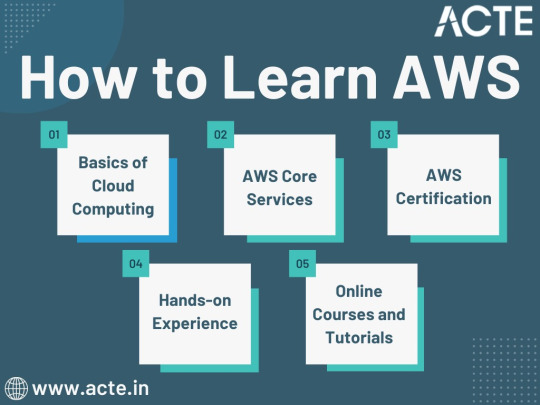
Amazon Web Services (AWS) represents an exciting frontier in the realm of cloud computing. As businesses and individuals increasingly rely on the cloud for innovation and scalability, AWS stands as a pivotal platform. The journey to AWS proficiency involves grasping fundamental cloud concepts, exploring core services, obtaining certifications, and acquiring practical experience. To expedite this process, online courses, tutorials, and structured training from renowned institutions like ACTE Technologies can be invaluable. ACTE Technologies' comprehensive AWS training programs provide hands-on experience, making your quest to master AWS more efficient and positioning you for a successful career in cloud technology.
8 notes
·
View notes
Video
youtube
AZ 900 - Azure fundamentals exam questions| Latest series |Part 11
#youtube#az900#azure#azuredeveloper#azure devops#azure data engineer training#azure fundamentals#it certifications online#it certification courses#cloud#cloud certification#cloud courses
0 notes